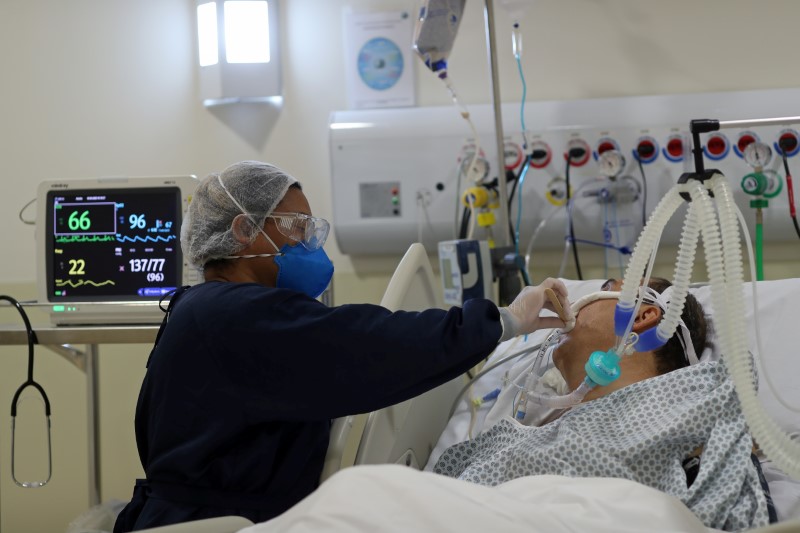RIO DE JANEIRO, BRAZIL – Between October and November, private hospitals in the city of São Paulo recorded an increase in Covid-19 hospitalizations. In this month alone, the Sírio-Libanês Hospital had 120 hospitalizations, 30 percent of which in intensive care units (ICUs).
“Our average was between 85 and 110 hospitalizations. We now have between 130 and 140 beds and this week’s occupancy is close to the peak of the pandemic in April,” says Felipe Duarte Silva, coordinator of the Sírio’s Medical Practices.
The Coração Hospital (HCor) recorded 36 hospitalizations between November 1st and 10th, at a rate that could exceed a total of 67 hospitalizations in October and 82 in September. Last month, there were five ICU admissions at HCor. In the first ten days of November, there have been seven.

At the Albert Einstein Hospital, the average hospitalizations for Covid-19 in April was 111 and, by November 9th, the average for this month stood at 55. Would the largest city in the country, the epicenter of the coronavirus pandemic, be on the verge of a second wave, as is currently the case in Europe?
According to researcher Vitor Mori, member of the Covid-19 BR Observatory, it is too early to tell. “There is still no consistent increase in the number of cases. We only know about the second wave when we are in it. But, without a doubt, the increase in hospitalizations in private hospitals is a warning signal to watch out for,” he says.
Evidence that this consistent increase of cases is not yet occurring is the number of hospitalizations in the city’s public hospitals. The Clínicas Hospital reports in a note that the average occupancy in recent weeks has remained at around 30 percent, “which corroborates the downward trend compared to the peak of the epidemic between the months of April and June when the HCor had an occupancy of over 90 percent of its ICU beds assigned to Covid-19”.
According to the Municipal Health Secretariat, the ICU occupancy rate for Covid-19 in all municipal hospitals stood at 37 percent (November 8th), below the rates recorded in April (56 percent), May (92 percent), and June (59 percent). At the Tide Setúbal Municipal Hospital, one of the hospitals dedicated for Covid-19 patients, with 70 ICU beds and 40 available ward beds, the ICU occupancy rate stood at 39 percent in October, compared to 52.9 percent in April.
Vitor Mori explains that this difference in occupancy between private and public hospitals may be due to the fact that the novel coronavirus spreads in clusters, as the scientific community prefers to call them. “It may have to do with the European summer, with the upper classes traveling there, who have access to private health care”, he says.
“What we see now may be a cluster among the wealthier classes who at first were working from home, managed to protect themselves more and are now more susceptible to the virus,” he adds.
Data blackout
In the whole state of São Paulo, while the rolling average for Covid-19 deaths has been dropping – on October 27th it was below 100 new daily deaths for the first time in six months – the average for new cases has been rising. On October 28th over 4,300 new cases were reported in a single day.
Five days later, the Ministry of Health reported an “incident” in its information systems that hindered updating the figures from some state Health Secretariats, such as São Paulo – a problem that was solved on Tuesday night. The latest official figures show 39,907 deaths and 1,150,872 cases of the novel coronavirus in the state.
However, since the blackout on Thursday, November 5th, the City Hall of São Paulo, which uses another data source, has already recorded over 900 deaths by the novel coronavirus which have not yet been included in the general statistics.
Vitor Mori believes that “at some point, cases will rise again” not only in São Paulo but in the whole country. “Due to the very cycle of the disease, there is a lag between the number of cases and the number of deaths, because it takes a while for the infection to be detected, to worsen and lead to potential hospitalization and death,” he explains.
However, the expert does not believe that a more restricted quarantine, as occurred in some cities in March and April, is possible, because of the need to preserve people’s mental health. “What should be done, then, is to encourage outdoor activities in well-ventilated spaces,” he says.
For physician Felipe Duarte Silva of the Sírio-Libanês Hospital, one of the challenges of this time of a new increase in cases is also to provide care for what he calls non-covid patients.
“We already know how to convert beds to attend Covid-19 patients, for instance. But the problem is to accommodate non-covid patients, which have increased in severity since April, because people were afraid to go to the hospital and be infected and worsened at home,” he laments, saying that demand for emergency room care has increased over the past month.
To address the situation, the coordinator of Medical Practices at the Sírio-Libanês is focusing on flow-based care, as virtually all health units have adopted in the pandemic, with separate areas for Covid-19 patients and transition zones. And to contain a potential second wave, he has only one formula: “Social distancing must be maintained. After all, the pandemic is not over.”
Source: El País

